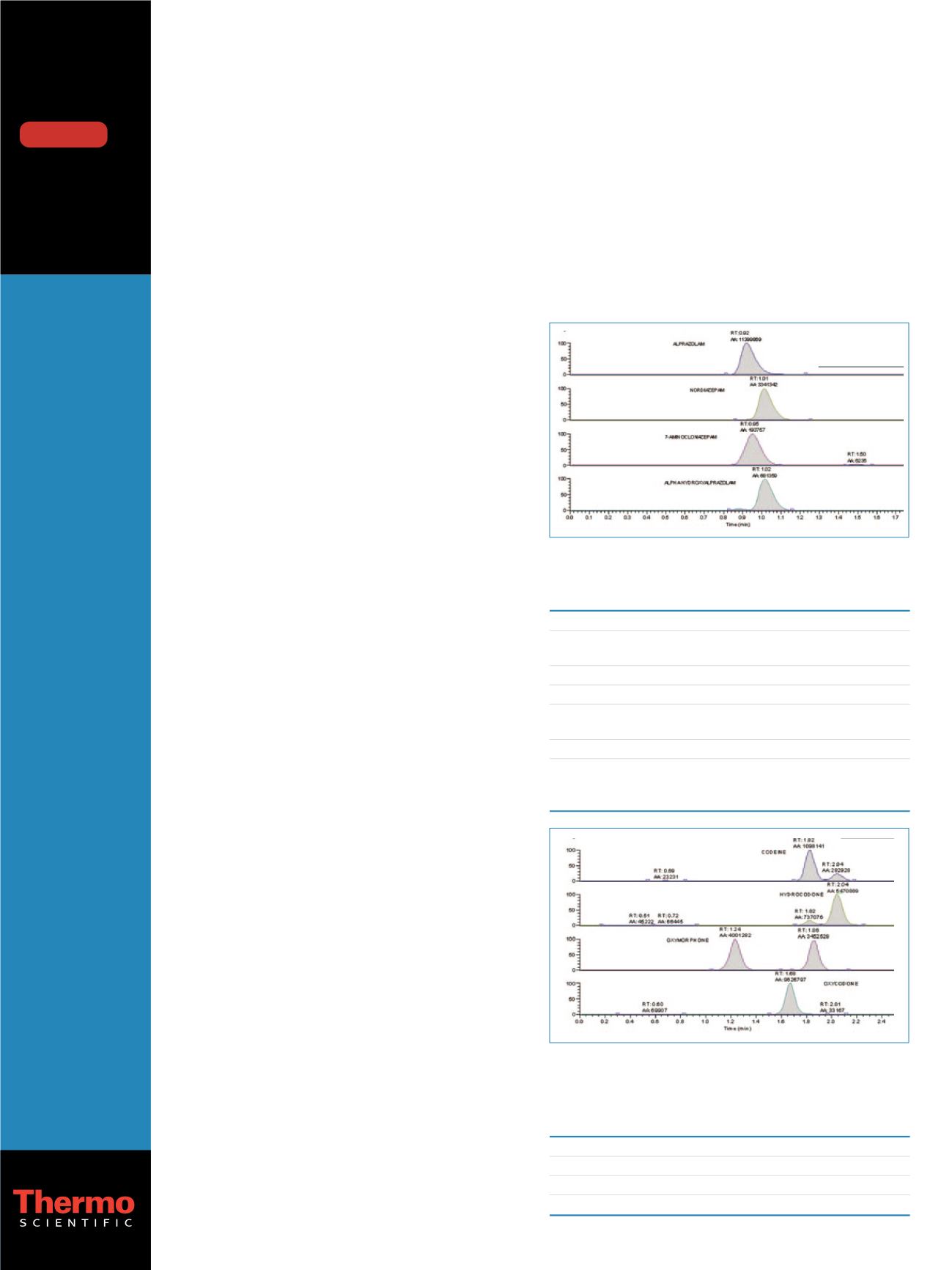

Simultaneous Analysis of Opiates and
Benzodiazepines in Urine in Under 3 Minutes
per Sample Using LC-MS/MS
Forensic Toxicology Use Only
Christopher L. Esposito, Matthew Berube, Francois Espourteille, Thermo Fisher Scientific, Franklin, MA
Introduction
A two-channel liquid chromatography separation method
has been developed for the simultaneous analysis of
opiates and benzodiazepines in urine for forensic use.
A Thermo Scientific Transcend TLX-2 system powered by
multiplexing and automated online sample preparation
technology was used to run two LC-MS/MS methods, one
for each class of compounds. The multiplexing technology
and data windowing of the system increase throughput
with minimal operator intervention.
Experimental Conditions
Sample Preparation
Urine samples were spiked with a deuterated internal
standard mix. Opiate samples were acidified to hydrolyze
the metabolites, and then all samples were centrifuged.
HPLC
HPLC analysis was performed using the Transcend
™
TLX-2 system. Samples were separated from the matrix
using Thermo Scientific TurboFlow Cyclone-P polymer
columns. Chromatographic separation was performed
using a Thermo Scientific Hypersil GOLD C18 column
(50 x 3 mm; 5
!
m) for benzodiazepines and a Hypersil
GOLD
™
PFP column (100 x 3 mm; 3
!
m) for opiates.
Mass Spectrometry
MS analysis was carried out on a Thermo Scientific TSQ
Quantum Access MAX triple stage quadrupole mass
spectrometer with a heated electrospray ionization source
(H-ESI). The selective reaction monitoring (SRM) mode
was used for mass spectrometry detection.
Results and Discussion
The analysis of directly-injected urine is accomplished for
both drug classes. Seven benzodiazepines and internal
standards and seven opiates and internal standards were
analyzed. Figures 1 and 2 display data-windowed runs for
selected benzodiazepines and opiates, respectively. Table 1
provides calibration curve statistics for several
benzodiazepines and opiates.
Conclusion
The Transcend TLX-2 system with its unique multiplexing
technology successfully runs two totally independent
channels for forensic use. Limits of detection were 1
ng/mL (25 ng/mL for morphine). Quantitative analysis
ranges were 5-5000 ng/mL for benzodiazepines and 50-
25,000 ng/mL for opiates. Multiplexing both channels for
analysis of benzodiazepines and opiates produces very
significant time savings. The total MS data collection run
times are efficiently reduced to less than 3 minutes per
sample, inclusive of online sample preparation, thus
resulting in more than 50% time savings versus running
the analyses separately.
Figure 1: Data-windowed run for selected benzodiazepines
Assay performance summary
Target Analytes
Benzodiazepines
Opiates
Matrix
Urine
Urine
LOD
1 ng/mL
1 ng/mL
(25 ng/mL morphine)
LOQ
5 ng/mL
50 ng/mL
Assay Linearity
1 ng/mL – 5 µg/mL
1 ng/mL – 25 µg/mL
Precision (%CV)
±15%
±15%
(20% at LLOQ)
(20% at LLOQ)
Sample Volume
10 µL
20 µL
Analysis Time
5.5 minutes,
7 minutes,
with a 2.5 minute data
with a 3 minute data
collection window
collection window
Figure 2: Data-windowed run for selected opiates
Table 1: Calibration curve statistics of 4 analytes
R
2
Analyte
(1/x weighing)
Range (ng/mL)
LOD (ng/mL)
Nordiazepam
0.9900
5-5000
1
Clonazepam
0.9960
5-5000
1
Oxymorphone
0.9903
50-25000
1
Hydromorphone
0.9950
50-25000
1
Key Words
• Transcend TLX-2
system
• TSQ Quantum
Access Max
• Forensic
Toxicology
• H-ESI
• SRM
Application
Note: 486b
DOWNLOAD


















